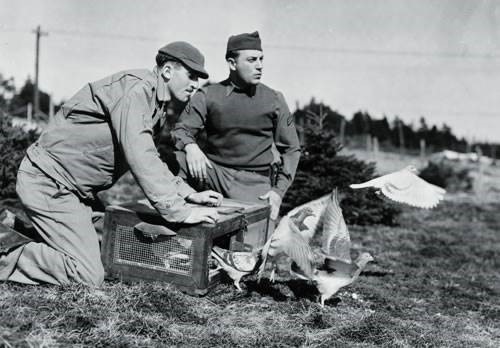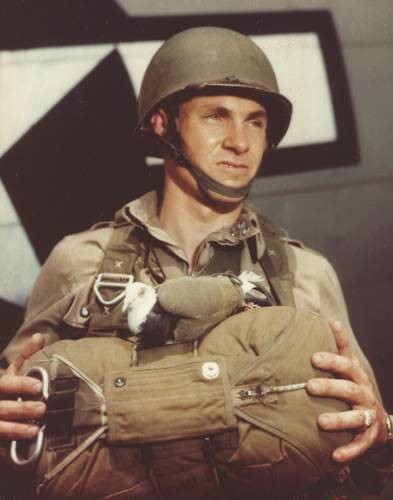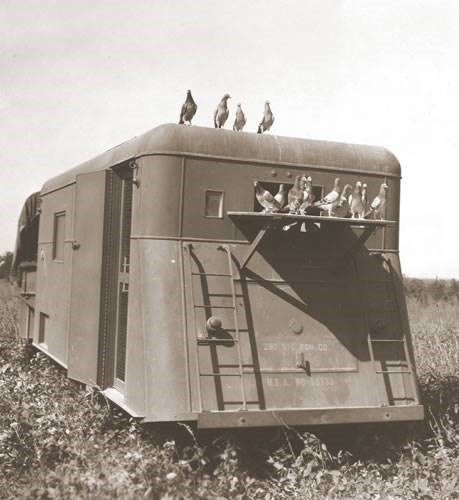The Ancient and Early Years of Pigeons
The sport of racing pigeons has evolved from the ancient hobby of keeping homing pigeons to carry messages. For centuries, pigeons had been used as message carriers by nobility, armies, and businessmen. The earliest record of the domestication of pigeons is from Egypt about 3000 BC. The sultan of Baghdad established a pigeon post system in AD 1150, and Genghis Khan used such a system as his conquests spread. Pigeons were widely used for messenger service in Europe during the Revolution of 1848, and in 1849 pigeons were used to carry messages during interruptions in telegraphic service between Berlin and Brussels. Homing pigeons were extremely important for communication in the centuries before electronic devices, such as the telegraph and telephone. The Reuters News Agency, one of the world’s largest information provider, began as a pigeon service carrying closing stock prices between Belgium and Germany.
Pigeons During Warfare as Recently as World War I and II
Pigeons were used as emergency message carriers in both World War I and II. The pigeons carried small messages initially in tubes attached to their feet but larger documents were later transported via a cigar-shaped tube attached to their backs. Most often, because of the accuracy of the pigeon’s skill in finding its correct destination and the difficulty in intercepting them, the messages were not even encoded, although the birds flew as far as 200 miles and often through hostile territory, including poison gas attacks during World War I.
They were also carried on ships so that in the event of a sinking by enemy submarines, the pigeons could be released to carry the location of the sinking to rescuers.
A bird called Cher Ami (“Dear Friend”) delivered a dozen vital messages and was thus awarded the famous French Croix de Guerre. Later she delivered a message that saved the lives of many soldiers in the “Lost Battalion” of the U.S. 77th Division.

Though shot in the chest and having lost most of one leg, the bird delivered the following message: “We are along the road parallel to 276.4. Our own artillery is dropping a barrage directly on us. For heaven’s sake, stop it.”. After she died in 1919, her body was stuffed and mounted, sent to the United States, and put on display at the Smithsonian Institution.
Joining the war effort was the American Racing Pigeon Union and the International Federation of American Homing Pigeon Fanciers. Many prize-winning and very valuable racing birds were turned over to the U.S. Signal Corps. Fanciers of the Greater Boston Homing Pigeon Concourse donated some of their birds during World War II


Pigeon breeding and training bases were set up in Georgia, Missouri, New Jersey, and Texas. The search was on for the fastest birds for the job at hand, the new crop of birds doubling the World War I distance, often traveling 400, sometimes 600, miles to accomplish their mission, and at times reaching 60 mph in short sprints. While some 50,000 birds were employed in military service during World War II, half that of World War I because of advances in electronic communication, they still played a significant role.
Additionally, many a British Royal Air Force crewman owed his life to a pigeon as one in every seven who had crashed landed or parachuted into the sea was rescued, thanks to a message delivered by one of the birds, which were often carried as standard passengers on English bombers.
Both sides in the war effectively employed birds to deliver messages. It was soon learned that the birds could withstand temperatures of -35 degrees and could be dropped from a plane at 375 mph without injury. In addition, a special pigeon-carrying sling was adopted by airborne troops that, once on the ground, converted into a backpack.
In The Longest Day, author Cornelius Ryan noted, “Correspondents on Juno [Beach] had no communications until Ronald Clark of United Press came ashore with two baskets of homing pigeons. The correspondents quickly wrote brief stories, placed them in the plastic capsules attached to the pigeons’ legs, and released the birds.
Modern Pigeon Racing
In the early 1800s, competitions were organized in Belgium, usually regarded as birthplace of the sport of racing pigeons. Belgium is still regarded as one of the largest hotbeds of the sport in the entire world.
Racing in the USA started in the 1870s in Philadelphia, in Canada soon thereafter. Today, there are two national organizations for racing pigeons in the US and one in Canada. The oldest organization is the International Federation of American Homing Pigeon Fanciers, Inc. (IF) formed in 1881. The largest organization is the American Racing Pigeon Union (AU) formed in 1910. The Canadian Racing Pigeon Union, Inc. was formed in 1929. Additional history about the AU and IF can be found on their websites: https://www.pigeon.org/history.htm and https://www.ifpigeon.com/about-the-if.html.
Currently in the US, there are homing pigeon clubs and fanciers in every state. In Massachusetts, the Greater Boston Homing Pigeon Concourse (GBHPC) was establish in 1928 and is one of the oldest, continuously operated racing pigeon organizations in the US. We organize races for associated area homing pigeon racing clubs and promote the sport.

GBHPC holds about 28 pigeon races per year. The races are held in the spring and in the fall and typically range from 100 miles to 600 miles in distance. The older birds that are usually one to six years in age are raced in the months of May and June from distances of 100 to 600 miles. The young birds are raced in the year that they are born, in the months of September and October from distances of 100 miles to 300 miles. The release locations for most GBHPC races are in Western Massachusetts, Upstate New York, and Ohio.
Some information obtained from:
http://www.americainwwii.com/articles/pigeons-of-war/,
https://www.britannica.com/sports/pigeon-racing,
https://sites.google.com/site/homingpigeonstraining/contact-me/history-of-racing-pigeons

